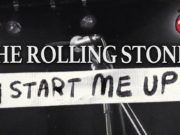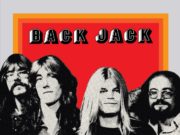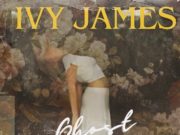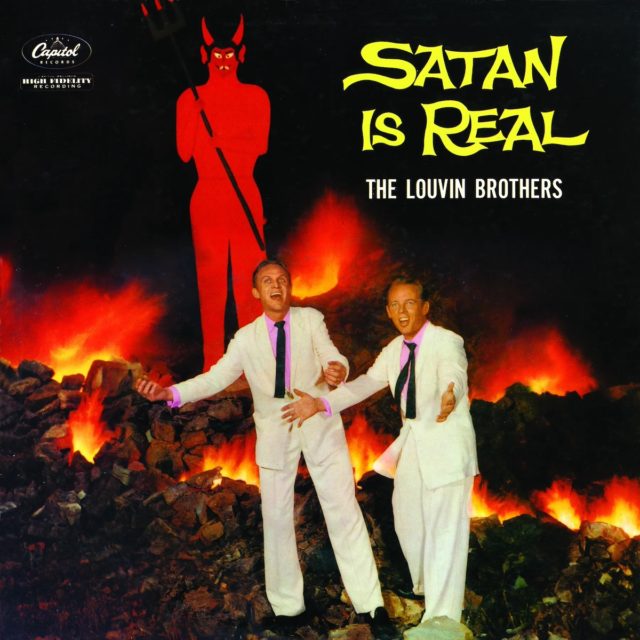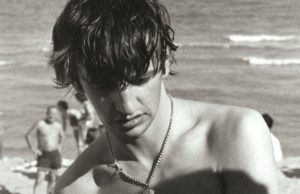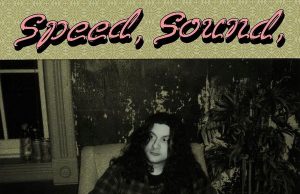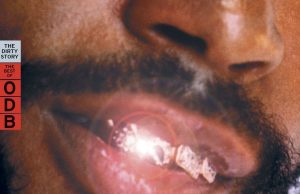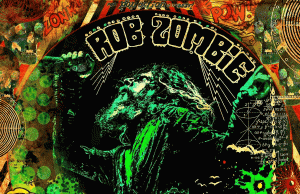Definition: Blood Harmony is an English expression meaning the extra special sound that siblings make when they sing together.
 No list of “hilarious album covers” is complete without Satan Is Real by The Louvin Brothers. I’m sure you’ve seen it — Charlie and Ira Louvin in matching white outfits, creeping around a rocky, charcoal-like, fiery terrain meant to be hell — with a rudimentary, cartoony grinning devil above their heads. In actual fact, the fiery terrain was created by burning tires in a quarry — and Satan was painted on a sheet of plywood.
No list of “hilarious album covers” is complete without Satan Is Real by The Louvin Brothers. I’m sure you’ve seen it — Charlie and Ira Louvin in matching white outfits, creeping around a rocky, charcoal-like, fiery terrain meant to be hell — with a rudimentary, cartoony grinning devil above their heads. In actual fact, the fiery terrain was created by burning tires in a quarry — and Satan was painted on a sheet of plywood.
Well, I just bought it. Remastered. For $30. Why? Because it’s incredible. The legendary gospel bluegrass album came out in 1959 on Capitol Records and represents one of the last albums the brothers made together before their split in 1963. Everyone eventually left Ira Louvin, and his younger brother finally had reached his limit as well. Despite a fierce Baptist upbringing and faith, Ira was a legendary boozer, womanizer and prone to violent outbursts. He was wanted by the law for DUI when he and his fourth wife were killed in a head-on crash — struck by a drunk driver on June 20, 1965. Ira (who, incidentally, designed the Satan Is Real cover), was just 41 years old.
After the 1963 split, the magic was gone. What always made The Louvin Brothers special was their unparalleled ability to harmonize — specifically in what’s referred to as close harmony, or close structure/close position. More common is what’s known as open harmony (or open structure/open position). The difference is that a chord in open harmony has more than an octave between the top and bottom notes, while close harmony has less than an octave between the top and bottom notes. Close harmony dates back to 1800s America and was common in gospel music, soul music as well as commercial radio quartets and barbershop. Time and again you’ll see a pattern with these groups — they’re often family. That’s why they call it blood harmony. I suppose Simon & Garfunkel and The Blind Boys of Alabama are obvious exceptions. But, we’ll examine some of these blood harmony groups and hopefully entice you to seek them out and listen to some freakishly gifted vocalists in a time when there was no AutoTune, no Melodyne, no digital editing, multiple partial takes and often the recordings were made live off the floor at the same time as the instrumental backing.
In other words: You had to be the real deal, and you had to be rehearsed. These are vocalists with a rare gift, and one which they must have worked very hard to nurture.
Charlie Louvin sang with his brother for two decades and was a firm believer that any song would benefit from harmonies. It was primarily Ira’s role to harmonize with Charlie’s lead — but the magic happened when the two voices would mix, swap roles and become indistinguishable from each other. More than 30 years after his brother’s death, Charlie said he was still hard-wired to expect his brother to step in and add harmonies. Like, literally — the men shared a microphone, so Charlie would simply take a step to the left so Ira could get on mic in the studio for his parts.
Speaking to NPR in 1996, Charlie explained how they put blood harmony to work for them, during their partnership: “My brother adapted a harmony that he thought sounded good, and it was always good enough for me. If it was obvious that the song was going to get too high for me to sing in a certain place, my brother would just automatically take that high lead and I would do the low harmony. We didn’t have to step on each other’s foot or wink or bump shoulders to do this. It was just something that you knew was going to happen in the song, and you’d go ahead and change to a part that you were capable of doing.” Behold:
’60s one-hit wonders Every Mother’s Son were sickeningly sweet, but so were their harmonies. At the heart of the band’s vocal attack were brothers Lary and Dennis Larden. Yeah, Lary is spelled that way. About the only against-the-grain thing I can find involving the quintet is the fact that drummer Chris Augustine is photographed reading a Playboy magazine on the back cover of their self-titled debut album. For fun, the swiftly released followup was called Every Mother’s Son’s Back. I’ll give you three guesses about what’s on the cover. As I said, the Larden boys could harmonize.
Canadian vocal quartet The Crew-Cuts also had two brothers — John and Ray Perkins. John, one year older, handled lead and tenor vocal while Ray brought the bottom. Named after a haircut, the Toronto lads were active for around a decade from the mid-’50s to the mid-’60s and had many singles, but two songs you’ve probably heard — Earth Angel and this beauty:
The story of Trio Lescano is fascinating. They were three Dutch sisters who became Italian citizens in 1942 by decree of King Victor Emanuel III at the behest of dictator Benito Musselini. Daughters of a disabled Hungarian acrobat, the sisters found fame singing in Italian after they moved with their operetta-singing mother to Turin in 1935. and had their names Italianized due to Fascist language laws. Maestro Carlo Prato took them under his wing and coached them in the art of close harmonies, modelled after America’s famous Boswell Sisters. They signed a deal with Parlophone. Alexandrina Leschan became Alessandra Lescano, Judith became Giuditta and Catherine became Caterina “Caterinetta” Lescano. They were almost immediately successful, and stayed together until 1946 when Catherine left due to disputes over money with her sisters.
As I mentioned, the Lescanos drew inspiration from The Boswell Sisters. The New Orleans trio were a huge deal during the Great Depression and were known not only for their close harmonies, but also abilities to improvise, change keys, tempo and time signatures, and sing scat and their own made-up language. The sisters were also multi-instrumentalists Martha, Connie and Vet were also easy on the eyes. They broke up in 1936 just as Trio Lescano were getting going. The Boswells’ big break happened in the 1932 film The Big Broadcast, and were one of the first acts to use the phrase Rock And Roll in 1934:
Another sister act influenced by the Boswells was The McGuire Sisters, who were kindergarten age around the time Boswells were at their peak. Ruby, Dorothy and Phyllis hailed from the Dayton, Ohio area (insert Guided By Voices joke here). Coincidentally, the year the Boswells were singing Rock And Roll in that nausea-nightmare boat set, the McGuires were having their first performances at weddings, funerals and revivals. By the late ’40s they had moved up to military bases and signed a record deal with Coral Records in 1952. Really, they were more aligned with the famous Andrews Sisters than the Boswells, and for a time, earned a reputation as a bit of an imitation — eventually pushing past that. The two trios crossed paths during their careers many times. Of course, those careers had much to do with Las Vegas in the early 1960s. The movie Sugartime (1995) deals with the McGuires and their connection — especially that of Phyllis — to Chicago mob boss Sam Giancana.
So, about those Andrews Sisters… they also began as Boswell imitators, but became much more successful than any or all of these blood harmony sister acts — selling 80 million records and becoming a household name. When modern artists like Christina Aguiliera, and previously Bette Midler, do boogie-woogie songs, this is who they are taking their cues from. LaVerne, Maxene and Patricia reached their peak in the years leading up to the U.S.’s entry into the Second World War, but stayed active through to the mid-’60s. These days, virtually every $1 bin at used record stores has at least one Andrews Sisters album in it. There are two songs of theirs which I can safely say, it’s virtually impossible to have never heard: Don’t Sit Under The Apple Tree (With Anyone Else But Me) and this…
There were all kinds of these groups. One imagines that parents of the era all checked to see if any of their kids had talent. Surely, Pearly and Violet Hamilton did. The Maryland pair teamed up with Jessie Fordyce to become Three X Sisters — extremely popular on NBC radio in the 1930s. In popular music, this style gave way to doo-wop of the ’50s and R&B of the 1960s and ’70s. Otherwise, it reigned in musical theatre. But, if you want blood harmony hitmakers in the ’50s and ’60s, you bought Everly Brothers records. Phil and Don hailed from Knoxville, and proved skilled at just about everything — folk, gospel, country, country-rock, rockabilly and rock ’n’ roll. They were a huge influence on the likes of The Beatles, Beach Boys and Simon & Garfunkel. Even Green Day frontman Billie Joe Armstrong teamed up with Norah Jones to do a shockingly incredible tribute album called Foreverly.
For the most part, Don sang baritone and Phil sang tenor harmony. But, like The Louvin Brothers, their voices would intricately overlap and sometimes be indistinguishable — and effortless. Textbook blood harmony.
The brothers boasted 35 Billboard Top 100 singles — more than two dozen in the Top 40. They hold the record for the most Top 100 singles by a duo. While their singing was pure and exalted, their relationship could be fraught. The broke up in 1973 after Phil infamously smashed a guitar on stage and walked off. They didn’t play together again for a decade.
Earl and Bill Bolick were singled out by their parents from their four other siblings for their singing ability. They were taught guitar, banjo and mandolin and learned to sing gospel. The North Carolina duo rose to prominence via coffee-sponsored radio programs and went through a series of hickory and nut-related names. They eventually settled on Blue Ridge Hillbillies — changing it to Blue Sky Boys after they successfully auditioned for RCA in 1936. They were big on the “hillbilly circuit” for a few years. This is when they did their best work. Then the Bolicks joined the war effort. After the Second World War, they got regular jobs, but still occasionally gigged. Due to the popularity of The Everly Brothers, the industry took a flier on them again. They cut two albums for Starday and two more for Capitol before calling it quits in the late 1960s. They were lured back into the biz for a while in the mid-’70s.
All these roads lead to arguably, the modern benchmark for blood harmony — the Wilson brothers of California, and their incredibly successful vocal group The Beach Boys. Formed outside of L.A. in 1961 by their father Murry as a garage band, brothers Brian, Dennis and Carl Wilson and their cousin Mike Love (and pal Al Jardine) would go on to become one of the most influential acts of the 1960s and early ’70s by taking the music of older pop vocal groups, merging it with rock ’n’ roll and R&B, and singing about surfing in elaborate, slightly nasal, falsetto harmony. With four out of five members being related, to me this counts as blood harmony.
The early formula, on the rockier songs, was for Love to take the lead and the others would provide the close harmonies. On ballads, it was usually Brian’s falsetto which took the lead. The harmony stack went like this, mostly — Love on the bottom, Carl above him, then Dennis or Al, and Brian on top. The vocal arrangements were almost entirely the creation of Brian, a self-taught musician who became a perfectionist very quickly. Sometimes he’d show the others what he wanted by multi-tracking himself singing all five parts. This is just sick:
And finally, here’s a playlist for you:
• • •
Area Resident is an Ottawa-based journalist, recording artist, music collector and re-seller. Hear (and buy) his music on Bandcamp, email him HERE, follow him on Instagram and check him out on Discogs.


